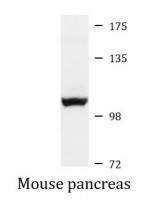ARG56137
anti-MBTPS1 antibody
anti-MBTPS1 antibody for Western blot and Human,Mouse

1
Overview
| Product Description | Rabbit Polyclonal antibody recognizes MBTPS1 |
|---|---|
| Tested Reactivity | Hu, Ms |
| Tested Application | WB |
| Host | Rabbit |
| Clonality | Polyclonal |
| Isotype | IgG |
| Target Name | MBTPS1 |
| Antigen Species | Human |
| Immunogen | Recombinant fusion protein corresponding to aa. 803-1052 of Human MBTPS1 (NP_003782.1). |
| Conjugation | Un-conjugated |
| Alternate Names | PCSK8; Endopeptidase S1P; EC 3.4.21.112; S1P; Membrane-bound transcription factor site-1 protease; SKI-1; Subtilisin/kexin-isozyme 1 |
Application Instructions
| Application Suggestion |
|
||||
|---|---|---|---|---|---|
| Application Note | * The dilutions indicate recommended starting dilutions and the optimal dilutions or concentrations should be determined by the scientist. | ||||
| Positive Control | K562 and Mouse pancreas | ||||
| Observed Size | ~ 110 kDa |
Properties
| Form | Liquid |
|---|---|
| Purification | Affinity purified. |
| Buffer | PBS (pH 7.3), 0.02% Sodium azide and 50% Glycerol. |
| Preservative | 0.02% Sodium azide |
| Stabilizer | 50% Glycerol |
| Storage Instruction | For continuous use, store undiluted antibody at 2-8°C for up to a week. For long-term storage, aliquot and store at -20°C. Storage in frost free freezers is not recommended. Avoid repeated freeze/thaw cycles. Suggest spin the vial prior to opening. The antibody solution should be gently mixed before use. |
| Note | For laboratory research only, not for drug, diagnostic or other use. |
Bioinformation
| Database Links |
Swiss-port # Q14703 Human Membrane-bound transcription factor site-1 protease Swiss-port # Q9WTZ2 Mouse Membrane-bound transcription factor site-1 protease |
|---|---|
| Gene Symbol | MBTPS1 |
| Gene Full Name | membrane-bound transcription factor peptidase, site 1 |
| Background | This gene encodes a member of the subtilisin-like proprotein convertase family, which includes proteases that process protein and peptide precursors trafficking through regulated or constitutive branches of the secretory pathway. The encoded protein undergoes an initial autocatalytic processing event in the ER to generate a heterodimer which exits the ER and sorts to the cis/medial-Golgi where a second autocatalytic event takes place and the catalytic activity is acquired. It encodes a type 1 membrane bound protease which is ubiquitously expressed and regulates cholesterol or lipid homeostasis via cleavage of substrates at non-basic residues. Mutations in this gene may be associated with lysosomal dysfunction. [provided by RefSeq, Feb 2014] |
| Function | Serine protease that catalyzes the first step in the proteolytic activation of the sterol regulatory element-binding proteins (SREBPs). Other known substrates are BDNF, GNPTAB and ATF6. Cleaves after hydrophobic or small residues, provided that Arg or Lys is in position P4. Cleaves known substrates after Arg-Ser-Val-Leu (SERBP-2), Arg-His-Leu-Leu (ATF6), Arg-Gly-Leu-Thr (BDNF) and its own propeptide after Arg-Arg-Leu-Leu. Mediates the protein cleavage of GNPTAB into subunit alpha and beta, thereby participating in biogenesis of lysosomes. [UniProt] |
| Calculated MW | 118 kDa |
| PTM | The 148 kDa zymogen is processed progressively into two membrane-bound 120 and 106 kDa forms in the endoplasmic reticulum, and late into a secreted 98 kDa form. The propeptide is autocatalytically removed through an intramolecular cleavage after Leu-186. Further cleavage generates 14, 10, and 8 kDa intermediates. |
Images (2) Click the Picture to Zoom In









